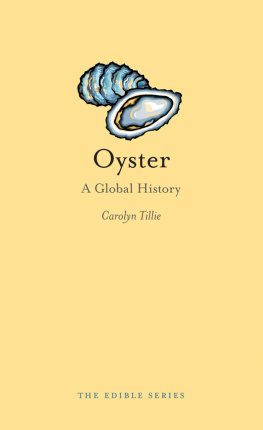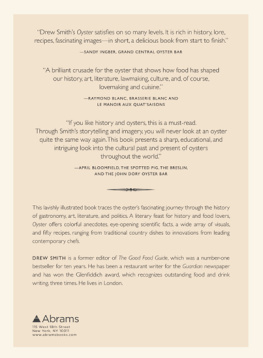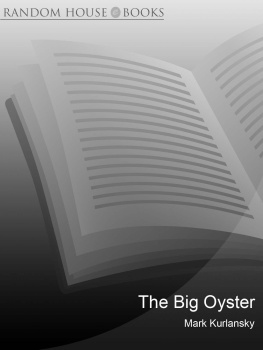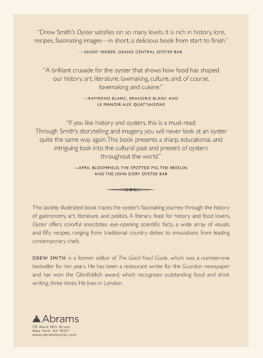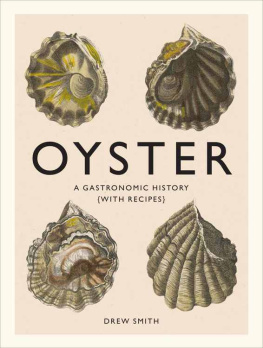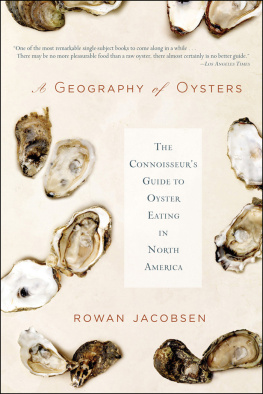OYSTER

Edible
Series Editor: Andrew F. Smith
EDIBLE is a revolutionary series of books dedicated to food and drink
that explores the rich history of cuisine. Each book reveals the global
history and culture of one type of food or beverage.
Already published
Apple Erika Janik Banana Lorna Piatti-Farnell
Barbecue Jonathan Deutsch and Megan J. Elias
Beef Lorna Piatti-Farnell Beer Gavin D. Smith
Brandy Becky Sue Epstein Bread William Rubel
Cake Nicola Humble Caviar Nichola Fletcher
Champagne Becky Sue Epstein Cheese Andrew Dalby
Chillies Heather Arndt Anderson Chocolate Sarah Moss
and Alexander Badenoch Cocktails Joseph M. Carlin
Corn Michael Owen Jones Curry Colleen Taylor Sen
Dates Nawal Nasrallah Doughnut Heather Delancey Hunwick
Dumplings Barbara Gallani Edible Flowers Constance L. Kirker
and Mary Newman Eggs Diane Toops Fats Michelle Phillipov
Figs David C. Sutton Game Paula Young Lee Gin Lesley Jacobs
Solmonson Hamburger Andrew F. Smith Herbs Gary Allen
Herring Kathy Hunt Honey Lucy M. Long Hot Dog Bruce Kraig
Ice Cream Laura B. Weiss Lamb Brian Yarvin Lemon Toby Sonneman
Lobster Elisabeth Townsend Melon Sylvia Lovegren Milk Hannah Velten
Moonshine Kevin R. Kosar Mushroom Cynthia D. Bertelsen
Nuts Ken Albala Offal Nina Edwards Olive Fabrizia Lanza
Onions and Garlic Martha Jay Oranges Clarissa Hyman
Oyster Carolyn Tillie Pancake Ken Albala Pasta and Noodles
Kantha Shelke Pie Janet Clarkson Pineapple Kaori OConnor
Pizza Carol Helstosky Pomegranate Damien Stone Pork Katharine
M. Rogers Potato Andrew F. Smith Pudding Jeri Quinzio
Rice Renee Marton Rum Richard Foss Salad Judith Weinraub
Salmon Nicolaas Mink Sandwich Bee Wilson Sauces Maryann Tebben
Sausage Gary Allen Seaweed Kaori OConnor Shrimp Yvette Florio Lane
Soup Janet Clarkson Spices Fred Czarra Sugar Andrew F. Smith
Tea Helen Saberi Tequila Ian Williams Truffle Zachary Nowak
Vodka Patricia Herlihy Water Ian Miller
Whiskey Kevin R. Kosar Wine Marc Millon
Oyster
A Global History
Carolyn Tillie
REAKTION BOOKS
Published by Reaktion Books Ltd
Unit 32, Waterside
4448 Wharf Road
London N1 7UX, UK
www.reaktionbooks.co.uk
First published 2017
Copyright Carolyn Tillie 2017
All rights reserved
No part of this publication may be reproduced, stored in a retrieval system, or transmitted, in any form or by any means, electronic, mechanical, photocopying, recording or otherwise, without the prior permission of the publishers
Page references in the Photo Acknowledgements and
Index match the printed edition of this book.
Printed and bound in China by Toppan Leefung Printing Limited
A catalogue record for this book is available from the British Library
eISBN: 9781780238760
Contents

Introduction

In the mid-1970s, as a twelve-year-old, I was taken to New Orleans by my parents to meet my Aunt Lola, one of my fathers five sisters. In the early 1960s, my Aunt Lola left her Georgia-born family, moved to the heart of the French Quarter, and worked as a Playboy bunny at one of the earliest of Hugh Hefners clubs devoted to female pulchritude. I remember flipping through her scrapbook of pictures and memorabilia, gazing at pictures of her with the likes of Bob Hope and Omar Sharif. I didnt understand most of what I was looking at, but inherently comprehended that like the fictional Auntie Mame Aunt Lola was a woman who was full of vitality, energy and an aura of joie de vivre I found very compelling. During the 1960s the New Orleans Playboy Club a converted old carriage house sat on Iberville Street in the same block as Felixs Oyster Bar and the Acme Oyster House. What I didnt know then, but understand now, is how this confluence of food and sex established a vortex in which my Aunt Lola thrived.
On our first night in New Orleans, she took us to Antoines Restaurant, one of the oldest dining establishments in America, where she knew some people. Winking at me, she ordered an oyster appetizer platter for the table to share while we perused the menu to decide our entre choices. On the table arrived a heaping tower of food, including Oysters Rockefeller, Oysters Thermidor, fried oysters and raw oysters on the half shell. With trepidation, I ate a fried oyster (what kid doesnt like fried food?). Not bad, I thought. Intrigued with the raw oysters, I copied Aunt Lola and drizzled a little mignonette atop the glistening greyness held inside the halfopen shell, and followed my gorgeous aunts every move as she taught me how to eat my first raw oyster. Hold it in the mouth, chew a little, taste the delicacy of the sea. In her fifties, Aunt Lola garnered attention from those around her, and my twelve-year-old brain didnt know that what she exuded was pure sex appeal, but somehow it translated to the consumption of these oysters that she enjoyed with such gusto. Such was the joy of my new gastronomic discovery that evening that instead of some other entre, my father let me order more oysters as a main meal. I idolized my aunt and I wanted to be just like her and my transmutation could only occur by the ingestion of the magical bivalve.

| Irish oyster from Galway Bay. |
Volumes have been written about this humble little creature; romantic favours extolled, great empires built and new lands discovered all because of this ancient shellfish. It is one of the oldest foods consumed by humans. At various points in history, the oyster has been the food of the rich and the sustenance of the poor. Various medicinal qualities were ascribed to it, with some physicians claiming it acted as an aphrodisiac while others said that it cooled the blood and related passions. It has been cooked in various ways, both simple and ornate, used as stuffing and eaten raw in all its glorious simplicity. It is, quite frankly, the perfect food.

Pacific oyster, waiting for shucking.
1
Definition and Science

The oyster is a magical animal, an ancient creature that has changed very little in the last two hundred million years. It is simple-looking with a complex life cycle. Generally, oysters start off male and settle into femaleness later in life. Most can change their gender and are considered protandrous (first, male) hermaphrodites, with some genera, like Ostrea edulis, the common European oyster, alternating back-and-forth throughout their entire lives. While it appears to be a singularly simple grey blob, the oyster actually has a heart, lungs, kidneys and colourless blood. Yet with no brain, it is a marvel of engineering for operating as a filter it can help clean the body of water in which it lives. The oyster is one of the oldest sources of food known to man and is considered a superfood. Naturally high in essential vitamins and minerals including protein, iron, omega-3 fatty acids, calcium and zinc, the oyster also contains vitamins A, B1 (thiamine), B2 (riboflavin), B3 (niacin), C (ascorbic acid) and D2 (calciferol). They are low in fat and highly nutritious. The encasing shell consists of 75 per cent calcium phosphate (calcite), calcium sulphate (gypsum), magnesium, aluminium salts and iron oxide. Assisting in bone growth, the shells are often ground up as a nutritional supplement for pregnant women who suffer from a calcium deficiency.

